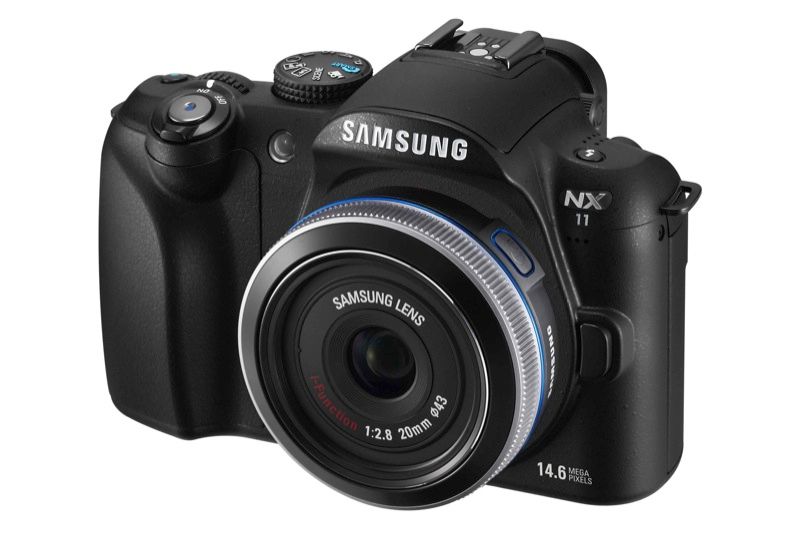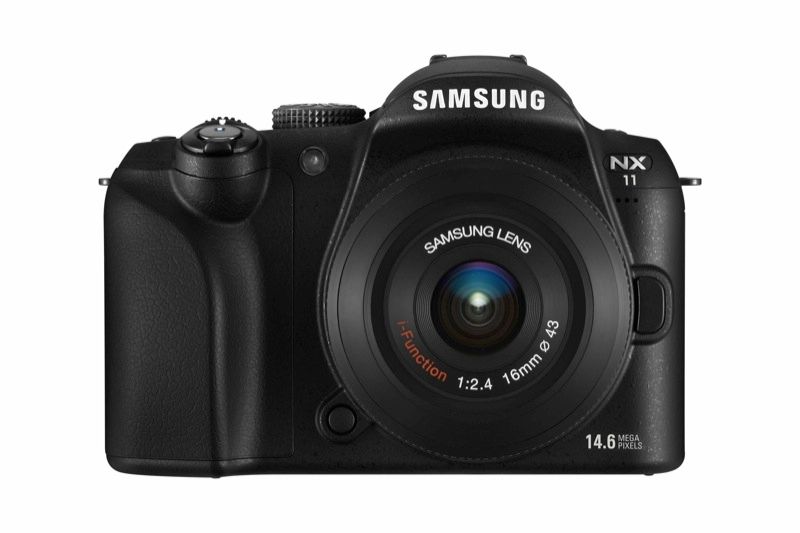Can the Samsung NX11 reinvent the hybrid camera category or is it much the same as the previous NX10 model but repackaged? We first got our hands on the Samsung NX11 back in January, where an extensive play with the latest hybrid or compact system camera showed us little advances over the previous NX10 model rather than a giant leap forward.
Our quick take
It’s all too easy to compare the NX11 to the NX10 till the cows come home. However, considering the NX11 on its own merit rather than solely as a comparative “update model”, and it’s certainly a strong camera; indeed it’s better than the NX10.
The autofocus improvements in both stills and movie shooting deserve a big thumbs-up, the i-Fn concept is a good one that’s genuinely useful, plus the camera feels good in the hand and is easy to use. Behind the scenes and the large CMOS sensor far outdoes a lot of the competition and would wipe the floor with compact cameras’ potential image quality.
Decent as it is, we’d be lying to say we’re not a teeny bit disappointed that the NX11 just doesn’t put that little bit extra on offer. We suspect the very near future will bring a more advanced NX-series model in order to further pep-up the range. But for now the NX11 stands tall and delivers the goods: if you’re after a DSLR-styled hybrid compact system camera then it is one of the best models out there.

Samsung NX11 - 4.5 / 5
| FOR | AGAINST |
|---|---|
|
|
The NX11’s single-most defining point is that it brings Samsung’s i-Function (i-Fn) lens concept to the wider market straight out of the box. This quick-access menu button on the actual lenses allows for rapid adjustment of the main settings (Aperture, Shutter, ISO, Exposure Compensation and others depending on the selected mode) by using the manual focus ring to cycle through them.
On the inside and the NX11 is a carbon copy of the NX10: the same 14.6-megapixel APS-C sized CMOS sensor and image processing engine (ISO 100-3200 is possible); 3-inch AMOLED screen (it’s very nice indeed); and 920K-dot electronic viewfinder.
The exterior adds a new, more ergonomic handgrip and the camera itself has a very DSLR-esque layout that’s easy to pick up and use. As well as full manual controls there’s Samsung’s Smart Auto and a bunch of Scene modes. New to the fold is a Panorama mode that captures panoramas in real-time by moving the camera through space (think Sony’s Sweep Panorama and you’ve hit the nail on the head), a Sound & Picture mode and Lens Priority mode that recognises the attached lens and optimises settings accordingly.
Panorama mode is good to use and, in general, stitches together well in-camera. Being able to shoot vertical-run panoramas rather than just horizontal ones is also a great touch. However the files themselves could be taller as the 848px height will only equate to around 30cms in printed form.
Lens Priority mode was less impressive, partly in that it felt redundant and also more like an extension of the Scene modes than an important independent mode. The literature regarding Lens Priority doesn’t make a great deal of sense and our first-hand use meant the mode offered Scene options through the i-Fn menu - much like a glorified Smart Auto but not a whole lot more.
Obviously Samsung sees the i-Fn lens idea as key for its sales. By axing the NX10 the current NX-series range (NX11 and NX100) both feature i-Fn lenses (the 18-55mm and 20-50mm respectively) straight from their standard kit boxes. And herein lies Samsung’s unique feature.
It’s worth pointing out that it was already possible to update the NX10 to be compatible with i-Fn lenses, so let’s not beat around the bush: for existing NX10 users the NX11 isn’t an upgrade model at all. Indeed the NX11 feels a lot like how the NX10 should have been upon its first release given that many of the new features and updates could have been implemented via software update.
Elsewhere and the NX11’s subtle improvements do help to make for a better overall experience: the autofocus system is now faster thanks to an improved focusing algorithm - and it really is notably improved. It’s not faultless, however, and close-ups or low-light subjects can often throw a spanner in the works that causes focusing to fail or miss the more obvious subject/contrasting area. Focusing on screen in live view is superior to competitor DSLR models, and although the NX11’s viewfinder is an essential tool to have, the speed of focusing here is identical - not the faster form that a DSLR would be able to offer.
The NX11’s movie mode also sees a reworking as the ability to use single or continuous autofocus ups the ante over the previous model. Although focusing transitions aren’t always perfect they’re usually on point and the expanded set of controls can only be a better thing. Lack of a Full HD 1080p option, full manual control or a mic input may leave some feeling short-changed, but otherwise the 720p capture option is good enough for everyday shooting.
In terms of image quality the NX11 has an ace up its sleeve: the large 14.6-megapixel APS-C CMOS sensor. In fact it’s as large as those found in almost all DSLR cameras and that means larger pixels on the sensor for better light distribution and therefore improved signal-to-noise ratio for, theoretically, a better resulting image. Only the Sony NEX-series shares a similar-sized sensor, while Panasonic’s and Olympus’s Micro Four Thirds offerings have smaller Live MOS sensors.
The NX11’s ISO 100-3200 range (not ISO 100-6400 as we were initially informed by Samsung at CES 2011) is fairly conservative by today’s ever-growing standards, but at least the NX11 doesn’t throw itself into offering pointless options so ridden with image noise that they’re not useable. The ISO 100-400 settings are clean, clear and sharp. ISO 800 through to ISO 1600 don’t maintain quite the same level of quality due to noise reduction processing, but files at all sensitivities are useable and resolve a good amount of detail.
Quality is, on the whole, very good though no different from the NX10 whatsoever. Saying that it does stand head and shoulders above the G-series Panasonic (excluding the GH2’s mightily impressive performance) and E-P-series Olympus models, and is very closely-run against Sony’s impressive NEX-5.
The biggest issue with the NX11 is its current lack of distribution. While competitor brands can be spotted in the likes of Tesco on Play.com it seems a loss to see Samsung unavailable at any of these sources. If that changes then the NX11 has a lot going for it - but it needs to reach the masses in order to have the right appeal. Jessops do stock it however at a competitive £479.95.
To recap
The Samsung NX11 is a subtle update of the NX10 that succeeds in bringing Samsung’s i-Fn technology to the fore from straight out of the box. Better autofocus and movie mode options as well as impressive image quality make this an easy-to-use and good all-rounder in the DSLR-styled hybrid camera sector



